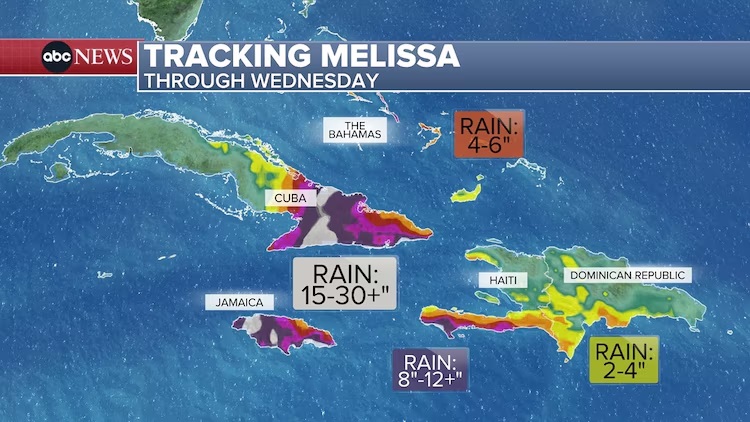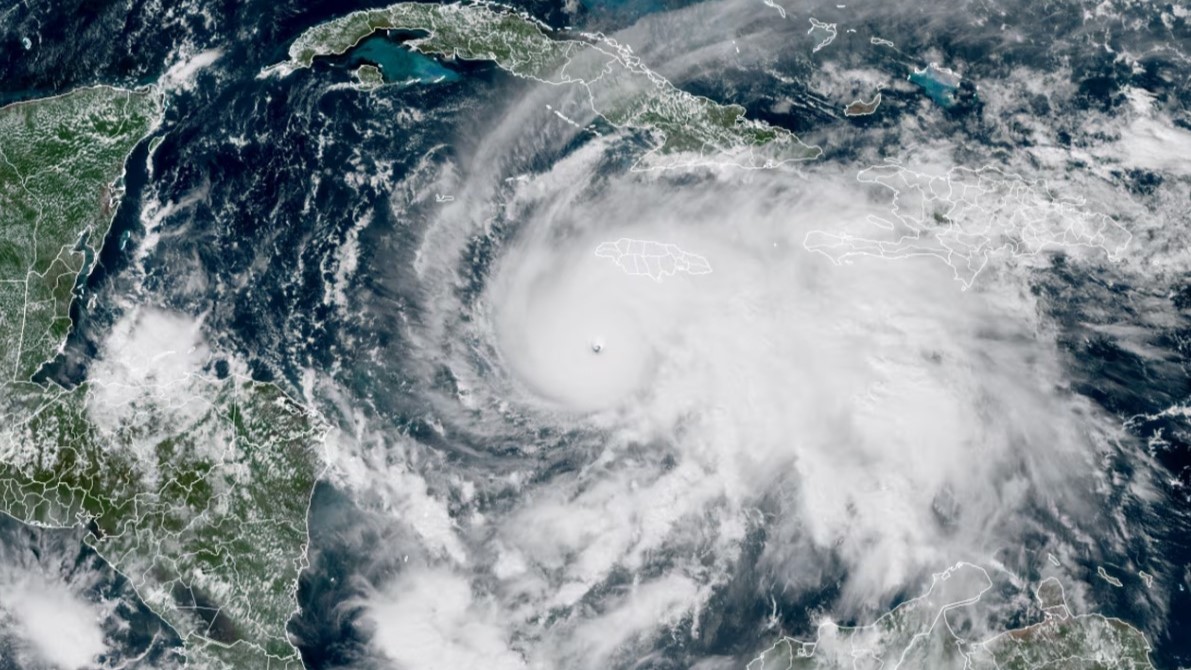Kingston, Jamaica — Torrential floodwaters lashed southwestern Jamaica, winds tore off roofs of buildings and toppled boulders on roads Tuesday as Hurricane Melissa came ashore as a catastrophic Category 5 storm, one of the strongest Atlantic hurricanes on record.
Landslides, downed trees and several power outages were reported, as Melissa hit with winds of 185 mph (295 kph) near New Hope, and officials warned that the cleanup and damage assessment process could be slow.
Prime Minister Andrew Holness said: “There is no infrastructure in the area that can withstand Category 5.” “The question now is how quickly we can recover. That’s the challenge.”
Hurricane Melissa made landfall in Jamaica as a catastrophic Category 5 storm, one of the strongest Atlantic hurricanes in history.
Desmond McKenzie, vice-chairman of Jamaica’s Disaster Risk Management Council, said floodwaters trapped at least three families in their homes in the Black River community in western Jamaica, and crews were unable to help them due to dangerous conditions.
“Roofs were flying off,” he said. “We hope and pray that the situation improves so that some attempts can be made to reach these people.”
He noted significant damage in southwestern St. Elizabeth Parish, which he said was “underwater.”
McKenzie said there were no confirmed reports of deaths and stressed that it was too early to talk about the extent of the damage because the hurricane – the strongest to hit the island since records began 174 years ago – was still battering the country.
Rohan Brown, of the Jamaica Meteorological Service, warned that as Melissa moves away from the coast, its counterclockwise rotation will bring a severe storm to northern Jamaica overnight. The storm is heading toward Cuba, where it is expected to make landfall as a major hurricane early Wednesday.
Nearly 15,000 people were in shelters in Jamaica, and about 540,000 customers, or 77%, were without power, officials said.
Colin Bogle, a Mercy Corps advisor, said most families were sheltering in place despite government orders to evacuate flood-prone communities. He was taking shelter with his grandmother in Portmore, where everything went dark after a powerful explosion.
“The noise is relentless,” he said. “People are anxious and trying to hold out until the storm passes.”
Jamaica is preparing to face the effects of a record storm
On Tuesday evening, Melissa had sustained winds of 145 mph (230 kph) and was moving from the northeast at 8 mph (13 kph) with its center moving into the Caribbean Sea, according to the U.S. National Hurricane Center in Miami. The hurricane’s center was about 15 miles (20 km) east of Montego Bay, Jamaica, and about 200 miles (325 km) southwest of Guantanamo, Cuba.
Its 185 mph (295 km/h) winds and 892 millibars of central pressure tied two records for the strongest Atlantic storm at landfall. Pressure — the main measure used by meteorologists — was linked to the 1935 Labor Day hurricane in Florida. Wind speeds linked the 1935 hurricane to 2019’s Hurricane Dorian, said hurricane scientists Phil Klotzbach of Colorado State University and Brian McNoldy of the University of Miami.
“It was an amazing storm, just a monster,” Klotzbach told The Associated Press.
With a life-threatening storm surge of up to 13 feet (4 meters) forecast, officials expressed concern about hospitals along the coast. McKenzie said four major hospitals were damaged, with the storm knocking out power at one of them, forcing officials to evacuate 75 patients.
One man called a radio station saying he urgently needed help for a woman in western Jamaica who had gone into labor as the storm approached land. The show host implored listeners to tell him which hospital was safest before calling in an obstetrician to provide detailed directions on how to deliver the baby, if necessary.
In Kingston, officials warned residents of the surrounding area to be careful of crocodiles that may be displaced from their habitats due to floods.
McKenzie said the government was ready for rescue operations once the storm passed: “We have boats, helicopters, you name it.”
The storm has already killed seven people in the Caribbean, including three in Jamaica, three in Haiti and one in the Dominican Republic, where another person is still missing.
Track Hurricane Melissa like a huge cat. 5 A storm is approaching Jamaica
Richard Thompson, acting director-general of Jamaica’s Office of Emergency Management, said officials met Tuesday evening to determine how best to clear debris after the storm and begin distributing emergency relief supplies to avoid bottlenecks at Jamaica’s ports.
Officials said they hope to reopen the island’s airports by Thursday.
UN agencies and dozens of non-profit organizations had placed food, medicine and other essential supplies awaiting the rush for distribution after the storm.
Melissa targets Cuba
Melissa is expected to make landfall in eastern Cuba late Tuesday or early Wednesday. Up to 20 inches (51 cm) of rain is expected in areas, along with a large storm surge along the coast.
In a televised address to the nation on Tuesday, Cuban President Miguel Díaz-Canel urged residents not to underestimate the strength of the storm, “the strongest ever to hit the national territory.”
In the eastern province of Santiago de Cuba, people flocked to the home of 83-year-old Edóviges Figueroa at the foot of the Sierra Maestra mountains in search of shelter after fleeing their homes in remote areas by buses, trucks and even horse-drawn carriages.
“We are helping as best we can,” she said. “Now I cook for everyone.”
People in Santiago de Cuba, the island’s second-largest city with a population of more than 1 million, spent Tuesday frantically preparing. A small number of people took to the streets, while state television showed Cubans in rural areas rounding up animals and protecting crops.
Diamon Mendoza, 36, did not hide her concern about the unavoidable storm.
“May God have mercy on us because he is coming with great force,” Mendoza said. “anything could happen.”
Authorities in the eastern province of Holguin prepared to evacuate more than 200,000 people on Tuesday, and had evacuated a similar number of people earlier from the town of Banes.
Reports on social media and state television showed blue and white buses transporting evacuees to shelters early Tuesday. Families held on to their children and belongings, while elderly people steadied themselves with sticks as they descended.
___
Cotto reported from San Juan, Puerto Rico. Associated Press journalists Geir Molson in Berlin, Andrea Rodriguez in Havana, Seth Bornstein in Washington and Ariel Fernandez in Santiago de Cuba contributed to this report.
Copyright © 2025 The Associated Press. All rights reserved.


